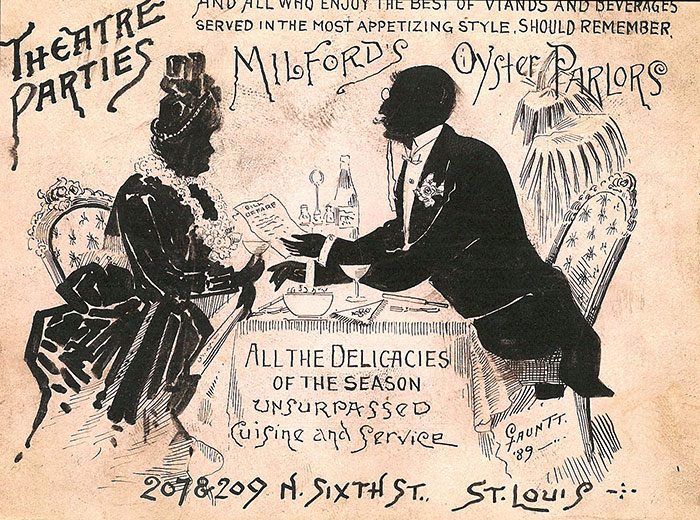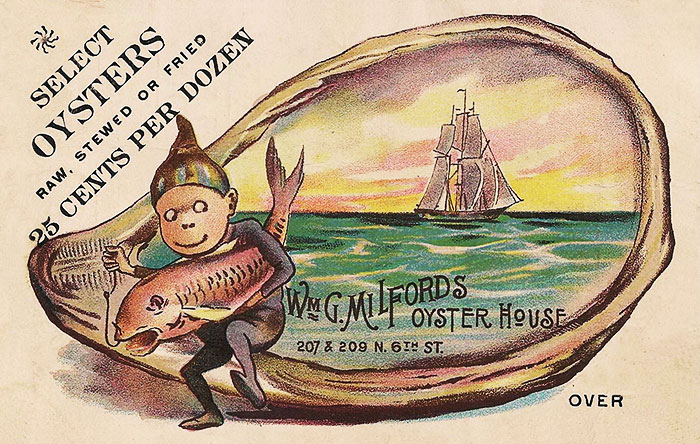|
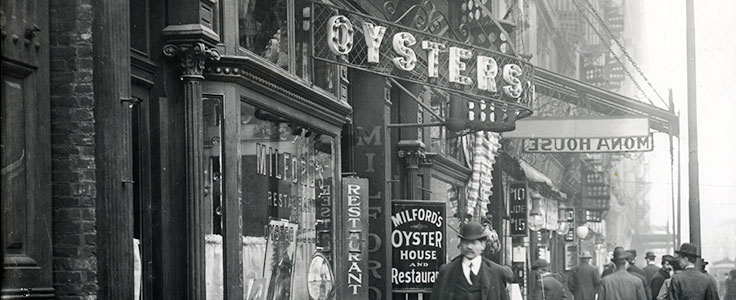
Milford's
Nearly every major town in North America had an oyster bar, oyster cellar, oyster parlor or oyster saloon by the middle of the nineteenth century. Oysters and bars often went hand-in-hand, because oysters were a cheap food to serve alongside beer and liquor.
In 1850s St. Louis, oysters could be had at Thoney's, Bulfins' and Grumley's oyster saloons, all on Third Street.
Oysters! Oysters! Just received, a fine lot of New York shell oysters at Thoney’s Oyster Saloon, No. 86 Third Street. Arrangements have been made for a full supply of the best oysters to be had in the New York market, and also a lot of Baltimore oysters, packed in ice. All of the oysters are warranted good.
St. Louis Globe-Democrat, Oct 24, 1853
Bulfins’ Oyster Saloon, situated under the Walton Hotel, is now open, and where he can be found at all hours ready to supply his friends and customers, either wholesale or retail. Also, in connection, a bar supplied with the best wines and liquors.
St. Louis Globe-Democrat, Jan 5, 1855
Grumley’s Oyster Saloon, No. 116 Third Street, has opened his spacious saloon for the oyster season, this day, where he will serve up at all times the best New York and Baltimore oysters, in the shell, in any style that may be called for.
St. Louis Globe-Democrat, Jan 6, 1855
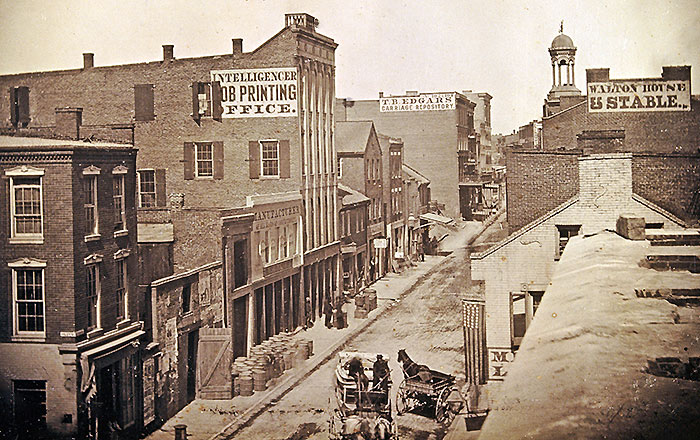 |
| Third Street, St. Louis, 1854 |
J. Y. Hart's Capitol Oyster Saloon was also well known in the city, with locations at both 57 Chesnut and 50 Olive streets.
Hart’s Capitol Oyster Saloon. Oysters in the Shell! Oysters in the Can!! Oysters in the Keg!!! Oysters in Every Way!!!! Princes Bay Oysters, York Bay Oysters, Shrewsbury Oysters, at all times in the shell, and opened by experienced hands at the counter, or sent home to families by the dozen or hundred. Daily Missouri Republican, Jan 8, 1858
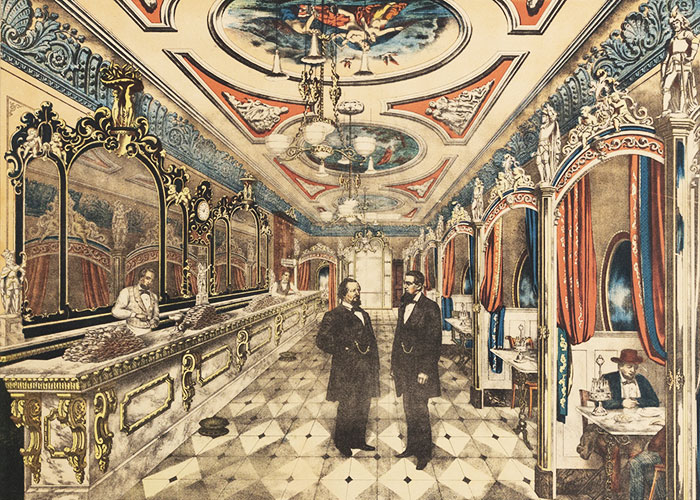 |
| J. Y. Hart's Capitol Oyster Saloon, 50 Olive Street |
Perhaps one of the "experienced hands at the counter" in the drawing above was George Milford. Milford was born in Wellington, Somerset, England in 1838. He came to St. Louis with his family in 1858 and secured a job as an "oyster opener" at Hart's Capitol Oyster Saloon.
In 1863, Milford partnered with John Lady to open his own oyster saloon at 21 North Third Street. Lady's career to that point had been as a money lender, and he may have provided the capital.
Lady & Milford are just in receipt of the finest lot of Saddle Rock Oysters in kegs and Rockaway Clams in shells as ever came to this city. Being sole agents in this city for the above, their friends and patrons can always depend on getting the finest oysters and clams the New York and Baltimore markets afford. The St. Louis public are already aware (notwithstanding the puffing of other oyster houses in the city) that they keep the best oysters in the western country. Daily Missouri Republican, Jan 15, 1865
By March of 1866, Milford had bought out Lady's interest in their oyster business. Not long after, he moved his oyster saloon to 104 North Third, between Chestnut and Pine.
George Milford, of No. 104 North Third street, is the largest shipper of oysters in St. Louis. In the retail portion of Mr. Milford’s establishment, which is the largest and most elegant in the city, the apartments are arranged with elegance and taste, and are in every way conducive to the comfort of guests. Oysters, admirably cooked in every know style, are there served by attendants who are thoroughly instructed in their duties, a matter which adds no little to the enjoyment of the patrons in the house, and tends greatly to the increase of its trade. St. Louis Globe-Democrat, Sept 3, 1876
 |
 |
Stranger's Guide to St. Louis, 1867
(click image to enlarge) |
City of St. Louis Block Book, 1876
(click image to enlarge) |
On April 9, 1877, Milford moved his business to 116 & 118 North Third, opening Milford's Restaurant & Oyster House. Private dining booths were a feature, and one could "breakfast, lunch or sup as privately as at home." Guests were provided with spirit stoves and could sip Bass ale while they cooked their own oysters. A handwritten menu listed Milford's Famed Scalloped Oysters as a feature on opening day.
Every man’s ability is best evident by his success, and upon this just measure of business knowledge George Milford, the great oyster dealer, becomes conspicuous.
In April 1877, he rented and removed to the Finn Building, Nos. 116 and 118 North Third Street, which he fitted up elegantly and where he is still doing business. Having the necessary room, Mr. Milford added a restaurant, the dining-hall of which is palatial and provided with all the auxiliaries necessary for comfort, attractiveness and the gratification of guests. His patronage is very large, including nearly all the prominent members of the Merchants’ Exchange and many other wealthy citizens, all of whom are served royally.
Popular as he is as a caterer to regular guests, Mr. Milford’s great reputation is founded on the oyster business, of which he continues to make a specialty. For the past fifteen years, he has stood at the head of oyster dealers in the West, his favorite brands being found in hundreds of cities, and everywhere regarded with the greatest favor. In this branch of his extensive business his sales reach one hundred thousand dollars annually, and every year the amount is increased. Mr. Milford occupies a high position in commercial circles and bears a reputation for integrity, affability and thorough comprehension of his business, which stamps him a popular success. A Tour of St. Louis, 1878
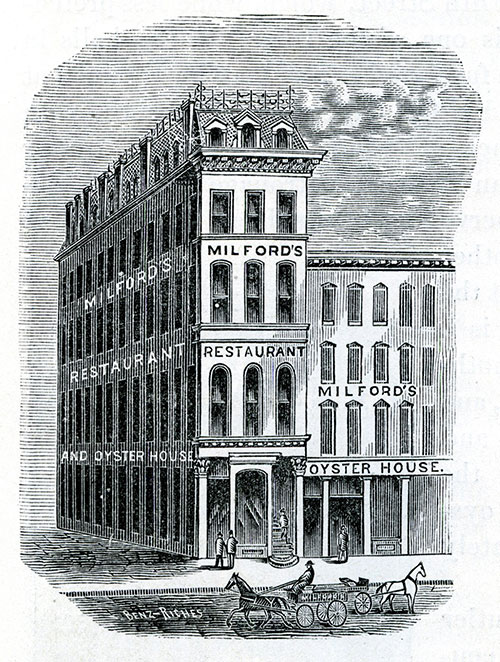 |
Milford's Restaurant & Oyster House
A Tour of St. Louis, 1878 |
Two years later, Milford was on the move again. On August 25, 1879, he opened "the most elegant Oyster House in the West" in at five-story building at 114 North Fifth Street. The following January, he opened "a large and elegant dining-room for ladies, and gentlemen when accompanied by ladies" on the second floor of his establishment.
George Milford's Oyster House & Restaurant continued to flourish on North Fifth Street until 1888, when Milford closed his business to join forces with his nephew, William G. Milford, who was operating a restaurant on Sixth Street.
The Milford Oyster and Restaurant Company was incorporated January 2, 1889. George Milford was president and William Milford assumed the position of general manager. But a difference in management styles led to uncle and nephew parting ways.
George Milford would lend his name to a handful of other oyster restaurants over the next few years. In 1905, he moved to Omaha, Nebraska, where he died on August 13, 1909 at the age of 72.
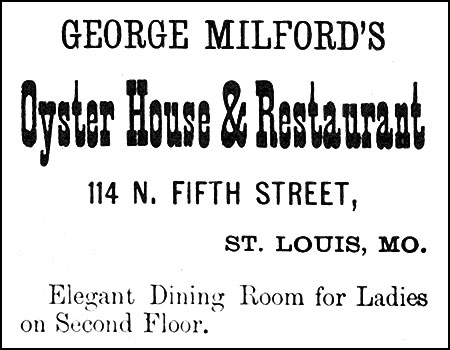 |
| Jewish Tribune, Sept 10, 1880 |
William Green Milford was born in Goodrich, Canada in 1862. His father, Joseph Milford, was one of three brothers who were born in England and came to North America at the beginning of the Civil War. Two came to the United States and Milford’s father went to Canada, coming to the United States with his family after the close of the war in 1864 and settling in St. Louis.
In 1885, Milford married Margarite Lilywalk. The couple had four children — Clarissa, William, Richard and Thomas.
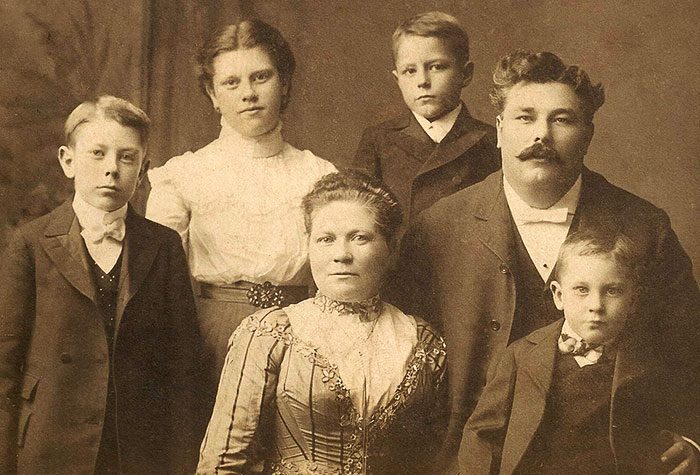 |
| William and Margarite Milford Family, circa 1900 |
At the age of 17, William Milford went to work for his uncle, George Milford, and learned the oyster trade. In 1882, William Milford opened his own oyster restaurant at 207 & 209 North Sixth Street, between Pine and Olive.
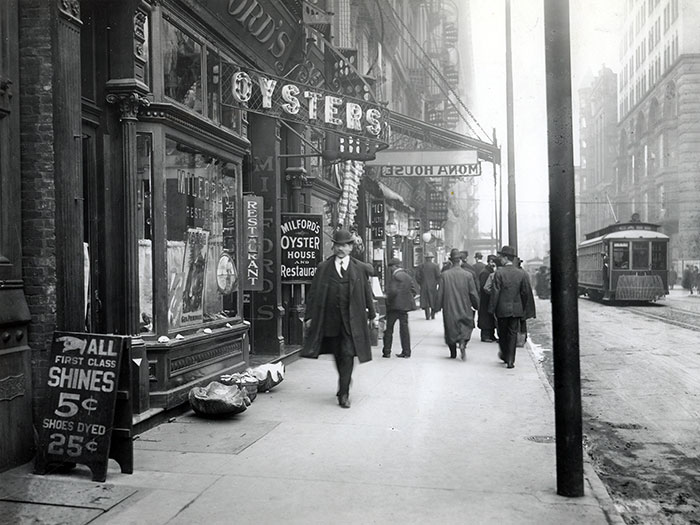 |
Milford's Oyster House, 207 & 209 North Sixth Street, circa 1900
(click image to enlarge) |
William Milford's restaurant was one of the most fashionable in the city. It was unique in that it was the last to have its oyster kitchen near the entrance. But Milford eventually discontinued this practice, as he explained in a September 11, 1904 St. Louis Globe-Democrat article.
The restaurants of this kind were always called oyster kitchens and had the range and serving counter in the front near the door. I don’t know why this arrangement obtained, though I believe it was a custom imported from England and developed in the Eastern cities of this country. No restaurant with any pretensions to being of the swell sort had its oyster range in the back kitchen — it was always in front, right where the guests could see their shellfish being prepared, and for a time was quite the rage. For various reasons I adhered to this former swagger custom for many years after it was discontinued by the other high-class restaurants, and for the past two or three years I have been absolutely unique in this respect. The range and its attendant serving counters, refrigerators, and so forth, takes up so much room, however, that I have finally decided to move it back where the other restaurants now prepare their shellfish, in the kitchen, and utilize the room thus gained for tables and chairs. This action on my part, therefore, marks the end of the restaurant fad that was so popular here even up to eight or ten years ago.
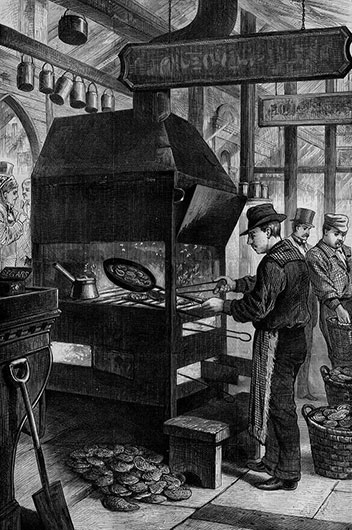 |
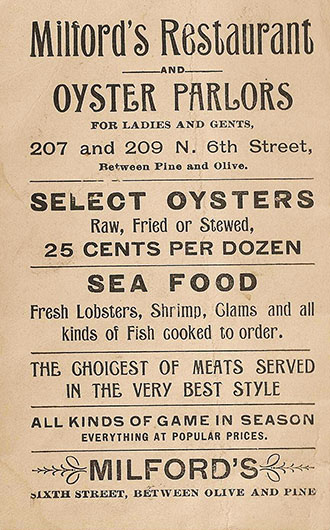 |
| Oyster Range |
Milford's Advertisement |
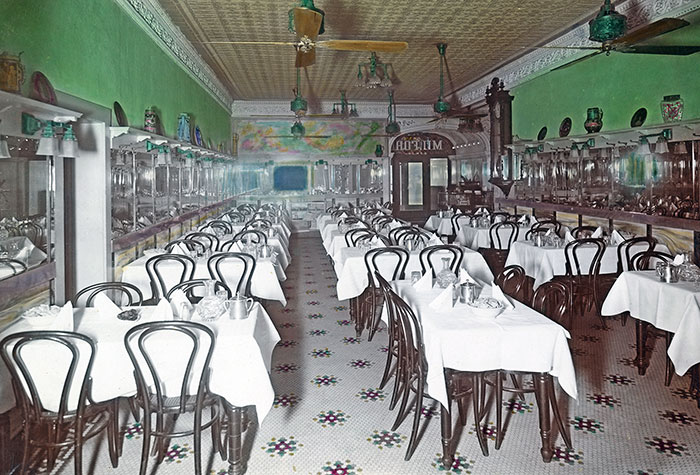 |
Milford's Oyster House & Restaurant, circa 1910
(click image to enlarge) |
Milford did extensive advertising in the area newspapers. He targeted women and promoted his famous Oyster Loaf.
To make your wife happy, take home an Oyster Loaf, 25c. Wm. G. Milford's. St. Louis Globe-Democrat, Nov 14, 1886
Try an Oyster Omelette, 35c. Wm. G. Milford's Oyster House. St. Louis Post-Dispatch, Apr 22, 1892
Our friend Milford is ready to serve the finest oysters at this time of the year and for all the successive months where there is a "R" in their names. Whatever you get at Milford's is first-class and fine. Try Milford's Oyster Loaves; nothing better. For theatre parties and other social functions Milford's restaurant can be heartily recommended. The Jewish Voice, Aug 10, 1906
Ladies shopping, try an Oyster Lunch. Milford's Restaurant.
St. Louis Globe-Democrat, Dec 10, 1907
Select oysters, 25c dozen; raw, fried or stewed. Milford's Restaurant, Beautiful. St. Louis Globe-Democrat, Sept 29, 1909
Milford's Oyster Loaf contains fried oysters, bottle catsup, pickles and crackers: 25c and 50c. St. Louis Post-Dispatch, Mar 29, 1911
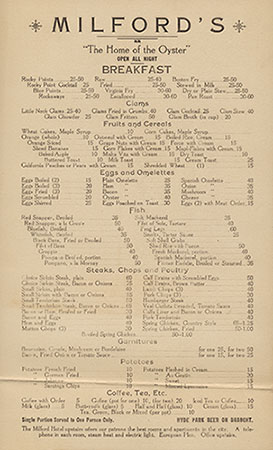 |
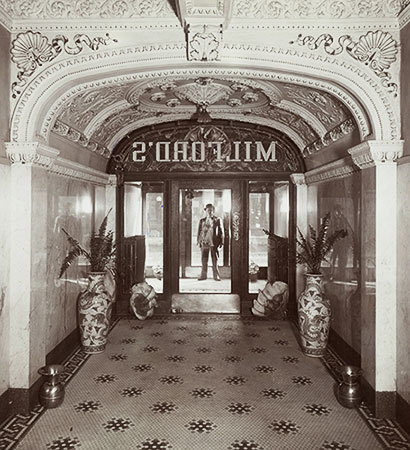 |
1911 Milford's Breakfast Menu
(click image to enlarge) |
Milford's Entrance
207 & 209 North Sixth Street |
William G. Milford died of a stroke on January 2, 1913 shortly after boarding a train at Union Station, preparing to take his first vacation in many years. He was 50 years old.
Milford's Oyster House and Restaurant continued to operate under the management of Milford's widow and two sons, Richard and William. In 1914, the restaurant's format and name were changed.
Milford's Oyster House has been changed under the same management to a popular-priced restaurant to be known as the "Eatwell." The waiters have been replaced with a corps of uniformed waitresses to give it a more home-like atmosphere. The Eatwell will cater especially to business men and women who want good things to eat and can get them with good service and attractive surroundings at popular prices.
St. Louis Star, Apr 8, 1914
Milford's Restaurant closed its doors permanently on April 1, 1915. But memories of oysters live on.
Old-timers will remember Milford’s, on Sixth street between Pine and Olive. Here also one found a pioneer, because the kitchen was on the street side, easily seen by passers-by. So spotless was it and so tasty the array of edibles that the place did a remarkable business for years, its specialty being oysters. There are still those living who can recall a Milford oyster loaf containing a dozen Rockaways which might be carried home piping hot with a bottle of catsup thrown in for good measure. The price was 25 cents per order. If you did not care for the loaf there was an oyster bar, where you ate the bivalves off the half-shell and settled your score with the cashier on the basis of 15 cents for a dozen shells.
St. Louis Globe-Democrat, Apr 16, 1933
Copyright © 2024
LostTables.com
Lost TablesTM
is a trademark of LostTables.com. All rights reserved. |













